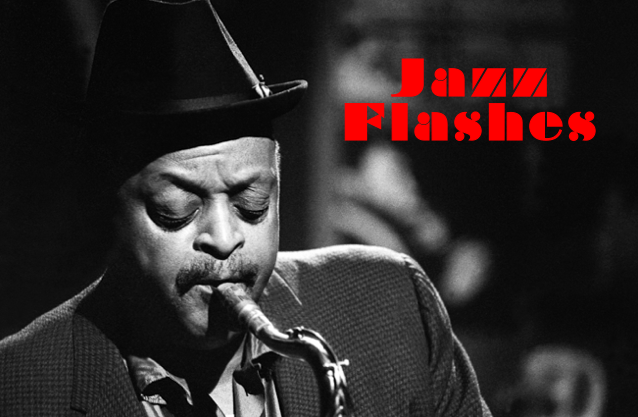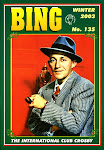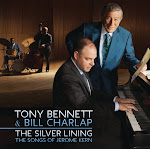While he often led sessions with small groups, particularly in the early years of his career, unfortunately not too many recordings of Duke Ellington in an octet setting have survived. The Duke Ellington Octet at the Rainbow Grille (Gambit Records, 2006) presents one of them, a very interesting date at New York' Rainbow Grille from August 17, 1967, preserved for posterity due to the fact that it was broadcast by the CBS radio network. The first five tunes on this album are apparently rehearsals that the sound engineer caught on tape while adjusting the balances in preparation for the broadcast. The first of these finds the Duke at the piano, wistfully playing a medley of two of his lesser-known compositions, "Heaven" and "Le Sucrier Velours," and in the background we can hear people chatting and glasses clinking, which suggests that nobody seems to be paying much attention to the performance. The whole octet begins to warm up next, using for that purpose classic Ellington numbers such as "In a Sentimental Mood," "Azure," and "I'm Beginning to See the Light," as well as a rocking tune called "Rock the Clock."
Then the broadcast proper begins, after an announcer urges the crowd to applaud as the band goes on the air, and the sound improves somewhat. The octet is made up of star soloists from within the Ellington orchestra, namely Cat Anderson on trumpet, Lawrence Brown on trombone, Johnny Hodges on alto, Paul Gonsalves on tenor, and Harry Carney on baritone, supported by a rhythm section that includes the Duke himself on piano, bassist John Lamb, and drummer Steve Little. This reduced lineup called for new arrangements, which in the hands of all these giants sound rich and full of excitement, giving all the horns plenty of chances to shine. The set list features many Ellington and Billy Strayhorn standards, such as "Take the 'A' Train," "Satin Doll," "Sophisticated Lady," "Passion Flower," "Solitude," and "Things Ain't What They Used to Be," as well as Juan Tizol's "Perdido," which is ably performed here by Cat Anderson. Ellington himself, of course, is heavily spotlighted on piano, and his playing, as usual, is never less than superb. This is definitely a very welcome release, with personnel information and well-written liner notes that could, however, be a little more detailed. It appears that several other performances from this Ellington octet engagement exist, and judging by the quality of the music we can hear on this CD, they all deserve the be issued commercially.
It is well known that Benny Goodman disliked to work with vocalists, and he only featured them with his legendary big band because of their selling potential. Thus, when he first played Carnegie Hall in January 1938 (a landmark concert that was to swing what the famous Paul Whiteman appearance at Aeolian Hall about a decade earlier had been to Whiteman's brand of symphonic jazz) he only allowed his female vocalist at the time, Martha Tilton, to sing two songs. Yet the physically and vocally attractive Liltin' Miss Tilton, as she was often billed, was always a crowd pleaser, and the roaring approval of the Carnegie Hall audience to her rendition of "Loch Lomond" prompted Goodman to step up to the microphone and clarify that, even though no encores had been prepared, Tilton would reappear later on in the show to sing another number. The audience's response to that second song, "Bei Mir Bist Du Schoen," was just as noisy proving that the public at large did not share the bespectacled bandleader's contempt for vocalists, who, in fact, would in time end up becoming one of the many reasons for the ultimate demise of the big band business.
Culled from live broadcasts made by the Goodman orchestra between 1937 and 1939, the generous two-CD set Liltin' (Jasmine Records, 2007) showcases Tilton's powerful yet unassuming vocals on 49 tracks that should be of interest to anyone who enjoys her Carnegie Hall performances. The sources of these recordings are broadcasts from the Camel Caravan radio show (1937-39) and airchecks that originated from the Madhattan Room in New York's Hotel Pennsylvania in 1937, all of them with very good sound considering the circumstances in which they were preserved. The quality of the songs varies, since Goodman featured on this broadcasts many throwaway pop hits of the day that have not stood the test of time, but the orchestra always sounds exciting because includes great names such as Harry James, Ziggy Elman, Jess Stacy, Bud Freeman, Hymie Schertzer, and Dave Tough, among many others. Moreover, when Tilton is given the right song (Cole Porter's "My Heart Belongs to Daddy" or Johnny Mercer's "And the Angels Sing," for instance) she always delivers, and the well-oiled sound of the orchestra never fails to get a enthusiastic responses from both the dancers and the listeners in the audience. Tilton would leave the Goodman organization in 1939 to launch a solo career, concentrating on radio work and making some fine records for Capitol, a label that was never sure whether to present her as a balladeer or a novelty performer. Offering several tracks that she never recorded commercially with Goodman and even a couple of excellent duets with Johnny Mercer, this collection serves as a fantastic introduction to the lilting voice of Martha Tilton directly from the bandstand.
And, finally, Kraft Music Hall: Selected Performances 1935-1936 (JSP Records, 2015) is an unexpected but wonderful surprise for all Bing Crosby fans and collectors, which we have just received from the International Club Crosby. Although the medium of radio was of paramount importance in Crosby's meteoric rise as a multimedia star in the 1930s, unfortunately not too many broadcasts from this early period of his career have survived. As the subtitle of this disc ("Lost radio recordings rediscovered and released here for the first time") suggests, this compilation attempts to fill that void by presenting material from early Kraft Music Hall programs that have not been heard since they first aired in 1935 and 1936. At that particular point in time, December of 1935, Crosby's old boss, Paul Whiteman, was still the host of KMH, and the singer was simply a guest on the program. While the show was broadcast from New York, Bing's segments were relayed from Hollywood, as we can hear on the first track of this album, which has Whiteman introducing Crosby, who was not backed by Whiteman's outfit but by the excellent, swinging Jimmy Dorsey orchestra. It appears that it was common practice for Crosby during his guest spots to sing a medley of songs associated with him or taken from one of his then-current movies, as well as a few tunes that he had introduced or helped make popular, such as "On Treasure Island," "Red Sails in the Sunset," "Dinah" (unfortunately sans the Mills Brothers here), and "After You've Gone." As John Newton observes in the liner notes, Bing sings the romantic ballad "I'm Yours," which "fits neither category, but is nevertheless a welcome addition" and would later be beautifully recorded by Dean Martin.
These performances are not interesting merely because of their rarity, but rather because they prove that Crosby was a master interpreter of popular song who was even more exciting, jazzy, and improvisatory when he was singing to a radio audience in front of a microphone and supported by a bandleader of the caliber of Jimmy Dorsey. On the December 26, 1935, broadcast, which includes a rather sleepy version of "I Get a Kick Out of You" by Kay Weber that sounds as though she were not getting any kicks out of singing the song, it becomes clear that Crosby is acquiring more protagonism, since he sings more numbers than on previous programs. In fact, come January 1936, Crosby began to host the KMH himself, quickly turning it into one of the most popular radio shows in the country, with a weekly listenership estimated at dozens of millions. From the first two shows hosted by Crosby we get some fantastic performances of songs like "Eeny-Meeny-Miney-Mo," "I'll See You in My Dreams," "A Little Bit Independent," and "Some of These Days," still backed by Dorsey, who would remain on the show until July 1937. This new release complements JSP's very recommendable 2007 four-CD set, The Vintage Years, which included broadcasts made between 1932 and 1950, featuring some interesting duets with Judy Garland and Jimmy Durante, and will delight Crosby fans for the scarcity of this type of material and also for the fact that it is up to the usual audio restoration standards of the fine British reissue label.
And, finally, Kraft Music Hall: Selected Performances 1935-1936 (JSP Records, 2015) is an unexpected but wonderful surprise for all Bing Crosby fans and collectors, which we have just received from the International Club Crosby. Although the medium of radio was of paramount importance in Crosby's meteoric rise as a multimedia star in the 1930s, unfortunately not too many broadcasts from this early period of his career have survived. As the subtitle of this disc ("Lost radio recordings rediscovered and released here for the first time") suggests, this compilation attempts to fill that void by presenting material from early Kraft Music Hall programs that have not been heard since they first aired in 1935 and 1936. At that particular point in time, December of 1935, Crosby's old boss, Paul Whiteman, was still the host of KMH, and the singer was simply a guest on the program. While the show was broadcast from New York, Bing's segments were relayed from Hollywood, as we can hear on the first track of this album, which has Whiteman introducing Crosby, who was not backed by Whiteman's outfit but by the excellent, swinging Jimmy Dorsey orchestra. It appears that it was common practice for Crosby during his guest spots to sing a medley of songs associated with him or taken from one of his then-current movies, as well as a few tunes that he had introduced or helped make popular, such as "On Treasure Island," "Red Sails in the Sunset," "Dinah" (unfortunately sans the Mills Brothers here), and "After You've Gone." As John Newton observes in the liner notes, Bing sings the romantic ballad "I'm Yours," which "fits neither category, but is nevertheless a welcome addition" and would later be beautifully recorded by Dean Martin.
These performances are not interesting merely because of their rarity, but rather because they prove that Crosby was a master interpreter of popular song who was even more exciting, jazzy, and improvisatory when he was singing to a radio audience in front of a microphone and supported by a bandleader of the caliber of Jimmy Dorsey. On the December 26, 1935, broadcast, which includes a rather sleepy version of "I Get a Kick Out of You" by Kay Weber that sounds as though she were not getting any kicks out of singing the song, it becomes clear that Crosby is acquiring more protagonism, since he sings more numbers than on previous programs. In fact, come January 1936, Crosby began to host the KMH himself, quickly turning it into one of the most popular radio shows in the country, with a weekly listenership estimated at dozens of millions. From the first two shows hosted by Crosby we get some fantastic performances of songs like "Eeny-Meeny-Miney-Mo," "I'll See You in My Dreams," "A Little Bit Independent," and "Some of These Days," still backed by Dorsey, who would remain on the show until July 1937. This new release complements JSP's very recommendable 2007 four-CD set, The Vintage Years, which included broadcasts made between 1932 and 1950, featuring some interesting duets with Judy Garland and Jimmy Durante, and will delight Crosby fans for the scarcity of this type of material and also for the fact that it is up to the usual audio restoration standards of the fine British reissue label.





































